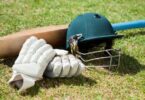Which stroke is known for its alternating arm movements and flutter kick?
(a) Breaststroke
(b) Backstroke
(c) Freestyle (Front Crawl)
(d) Butterfly Stroke
Which swimming stroke is also referred to as the “fly”?
(a) Breaststroke
(b) Backstroke
(c) Freestyle
(d) Butterfly Stroke
What is the maximum distance of the standard Olympic pool in meters?
(a) 20 meters
(b) 50 meters
(c) 100 meters
(d) 200 meters
In which stroke does the swimmer lie on their back and use alternating arm movements and a flutter kick?
(a) Breaststroke
(b) Backstroke
(c) Front Crawl
(d) Butterfly Stroke
Related: Table Tennis questions
Which part of the breaststroke involves a simultaneous leg movement resembling a frog kick?
(a) Flutter kick
(b) Scissor kick
(c) Dolphin kick
(d) Whirlwind kick
What is the breathing pattern typically used in breaststroke swimming?
(a) Breathing only above water
(b) Breathing only underwater
(c) Breathing with every arm pull
(d) Breathing with every leg kick
In which year did swimming become an official Olympic sport?
(a) 1892
(b) 1900
(c) 1920
(d) 1936
In which ancient civilization was swimming depicted in wall paintings and records?
(a) Ancient Greece
(b) Ancient Egypt
(c) Ancient Rome
(d) Ancient China
In a medley relay, what does each team member swim the order of strokes?
(a) Freestyle, Backstroke, Butterfly, Breaststroke
(b) Backstroke, Breaststroke, Butterfly, Freestyle
(c) Butterfly, Breaststroke, Backstroke, Freestyle
(d) Freestyle, Butterfly, Breaststroke, Backstroke
In backstroke swimming, which body position is essential for minimizing resistance and maintaining balance?
(a) Upright position
(b) Prone position
(c) Supine position
(d) Tucked position
Related: Super Bowl Facts and Trivia Quiz
What is the primary difference between backstroke and other strokes concerning breathing?
(a) Breathing through the nose
(b) Breathing only above water
(c) Breathing through a snorkel
(d) Breathing underwater
What is the standard length of an Olympic-sized swimming pool used in most international competitions?
(a) 25 meters
(b) 50 meters
(c) 75 meters
(d) 100 meters
When did swimming first become an organized sport?
(a) 12th century
(b) 16th century
(c) 19th century
(d) 20th century
What is the name of the official responsible for recording the swimmers’ times in a competition?
(a) Timer
(b) Starter
(c) Referee
(d) Judge
What is the primary responsibility of the “referee” in a swimming event?
(a) To coach the swimmers
(b) To announce the race winners
(c) To ensure that all rules are followed
Related: The Ultimate Baseball Quiz
Who is considered the “Father of Modern Swimming”?
(a) Michael Phelps
(b) Mark Spitz
(c) Duke Kahanamoku
(d) Johnny Weissmuller
What is the governing body responsible for international competitive swimming, including setting rules and organizing significant events?
(a) International Swimming Federation
(b) International Olympic Committee
(c) Fédération Internationale de Swimming Association
(d) World Swimming Organization
In which event are swimmers allowed to represent their respective countries and compete together in teams?
(a) Individual Medley
(b) Relay
(c) Freestyle
(d) Backstroke
Related: Indoor games Questions and Answers
Which swimmer is known for her dominance in women’s distance freestyle events, winning multiple Olympic and world championship titles?
(a) Missy Franklin
(b) Sarah Sjöström
(c) Federica Pellegrini
(d) Katie Ledecky
Who is the Australian swimmer known for his nickname “Thorpedo”?
(a) Michael Klim
(b) Caeleb Dressel
(c) Grant Hackett
(d) Adam Peaty
What is the designated area at the end of a competitive pool where swimmers turn and push off during a race?
(a) Starting Block
(b) Flip Turn Zone
(c) TouchPad
(d) Wall
What is the term for the technique used to increase propulsion during the arm pull by pressing the forearm and hand backward?
(a) Flutter Kick
(b) Pulling Motion
(c) Sculling
(d) Whip Kick
Related: Volleyball Trivia Questions, Answers
How can swimming contribute to mental well-being?
(a) By promoting social isolation
(b) By increasing stress levels
(c) By enhancing mood and reducing anxiety
(d) By worsening cognitive function
Who currently holds the record for the most Olympic gold medals in swimming?
(a) Ian Thorpe
(b) Michael Phelps
(c) Katie Ledecky
(d) Ryan Lochte
Which of the following injuries is a common overuse injury among swimmers due to repetitive Motion of the shoulder joint?
(a) Sprained ankle
(b) Broken wrist
(c) Tennis elbow
(d) Shin splints
What is a common term for inflammation of the connective tissue on the sole, often experienced by swimmers?
(a) Plantar fasciitis
(b) Patellar tendinitis
(c) Rotator cuff tear
(d) Groin strain
What is the critical characteristic of the sidestroke swimming technique?
(a) Continuous flutter kick
(b) Alternating arm pulls
(c) Synchronized breathing
(d) Continuous dolphin kick
Which part of the body remains above water during the sidestroke?
(a) The head
(b) The shoulders
(c) The hips
(d) The legs
How does swimming help enhance lung capacity?
(a) By restricting the breath
(b) By reducing oxygen intake
(c) By exposing lungs to cold water
(d) By encouraging deep and controlled breathing
What is a crucial technique for efficient breathing during swimming?
(a) Holding your breath for as long as possible
(b) Exhaling underwater and inhaling above water
(c) Breathing rapidly to maintain oxygen levels
(d) Breathing through your nose while underwater
Which aspect of swimming can help improve muscle strength and tone?
(a) Decreased resistance in the water
(b) Sedentary posture
(c) Buoyancy effect
(d) Resistance against water’s viscosity
Which swimming stroke involves an alternating motion of the arms and a simultaneous “frog kick” Motion of the legs?
(a) Breaststroke
(b) Backstroke
(c) Freestyle
(d) Butterfly Stroke
Related: Boxing Trivia Questions
Swimmer’s ear, an infection of the ear canal, is often caused by:
(a) Inadequate hydration
(b) Chlorine exposure
(c) Overhydration
(d) Sunburn
What is the primary purpose of the sidestroke in swimming?
(a) Speed and efficiency
(b) Competitive racing
(c) Lifesaving and endurance
(d) Aerobic conditioning
Which stroke is often colloquially referred to as “freestyle” in competitive swimming?
(a) Breaststroke
(b) Backstroke
(c) Butterfly
(d) Front Crawl
What can you do to prevent muscle cramps while swimming?
(a) Avoid drinking water before swimming
(b) Only swim in cold water to prevent overheating
(c) Stay hydrated and warm up before swimming
Which swimmer holds the world record for the women’s 200m butterfly event?
(a) Katie Ledecky
(b) Sarah Sjöström
(c) Federica Pellegrini
(d) Michael Phelps
Related: Track and Field Quiz Questions with Answers
What is the term used for the technique of rotating the body along its axis during each arm pull in freestyle or backstroke?
(a) Flip Turn
(b) Streamline
(c) Rotation
(d) Body Roll
What is the distinctive arm movement in the breaststroke swimming technique?
(a) Alternating arm strokes
(b) Synchronized arm and leg movement
(c) Circular arm sweep followed by extension
(d) Overhead arm rotation
What is the name of the competition where a swimmer covers a specific distance using any stroke of their choice?
(a) Medley
(b) Freestyle
(c) Butterfly
(d) Relay
In freestyle swimming, how is the breathing typically timed?
(a) Breathing only above water
(b) Breathing only underwater
(c) Breathing with every arm pull
(d) Breathing with every leg kick
Related: Best Golf Trivia Questions & Answers
Who is often referred to as the “Flying Fish”?
(a) Katie Ledecky
(b) Ian Thorpe
(c) Michael Phelps
(d) Simone Manuel






